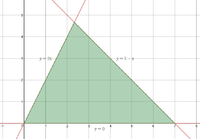the answer is (3;3) Your formula is correct, can you explain how this formula works, please. Depend on which conditions? Does the order of lines matter? Is there a general rule?
Consider a plot of the 3 given lines, with the triangular region bounded by these lines shaded in green:

Now, we see that the bottom of the triangle lies along the line \(y=0\) and so the \(y\)-coordinates of all points within the triangle must satisfy:
[MATH]0<y[/MATH]
Next, observe that the left side of the triangle lies along the line \(y=2x\), so all points must be to the right of that line. If we pick such a point like \((1,1)\), and substitute that into the line, we find:
[MATH]1<2(1)[/MATH]
And so all points within the triangle also must satisfy:
[MATH]y<2x[/MATH]
Finally, we see the right side of the triangle lies along the line \(y=7-x\) and if we again use the point \((1,1)\), we find:
[MATH]1<7-1[/MATH]
And so all points within the triangle also must satisfy:
[MATH]y<7-x[/MATH]
And thus we may conclude that any point \((x,y)\) that simultaneously satisfies all 3 conditions must lie within the triangular region bounded by the 3 given lines.

